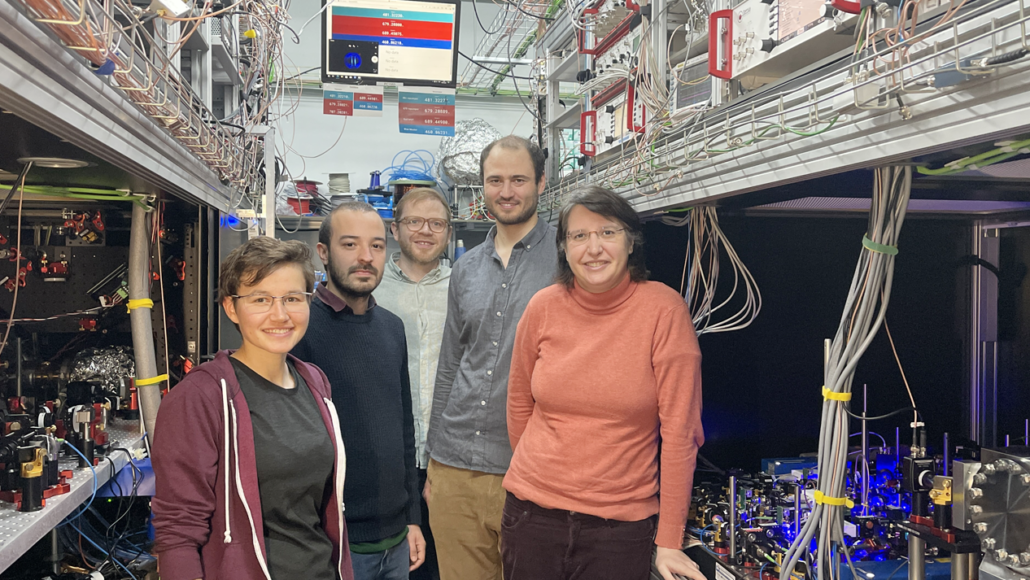QUIONE, a quantum simulator capable of observing individual atoms in a strontium quantum gas
Quantum physics needs high-precision sensing techniques to delve deeper into the microscopic properties of materials. From the analog quantum processors that have emerged recently, the so-called quantum-gas microscopes have proven to be powerful tools for understanding quantum systems at the atomic level. These devices produce images of quantum gases with very high resolution: they allow individual atoms to be detected.
The World’s First Strontium Quantum Gas Microscope Developed at ICFO Opens New Avenues for Quantum Simulation.
Now, ICFO researchers and Dynamite team members Sandra Buob, Jonatan Höschele, Dr. Vasiliy Makhalov and Dr. Antonio Rubio-Abadal, led by ICREA Professor at ICFO Leticia Tarruell, explain in a new article in PRX Quantum how they built their own quantum-gas microscope, named QUIONE after the Greek goddess of snow. The group’s quantum-gas microscope is the only one imaging individual atoms of strontium quantum gases in the world, as well as the first of its kind in Spain.
Beyond the impactful images that distinguish individual atoms, the goal of QUIONE is quantum simulation. As ICREA Prof. Leticia Tarruell explains: “Researchers can use quantum simulation to boil down very complicated systems into simpler models to then understand open questions that current computers cannot answer, such as why some materials conduct electricity without any losses even at relatively high temperatures”. The Royal Spanish Society of Physics awarded the ICFO research group for their work in this area, and they have also received projects and grants from the BBVA Foundation, Ramón Areces Foundation, La Caixa Foundation, and Cellex Foundation at the national level. European-level support includes an ERC project.
The singularity of this experiment lies in the fact that they have managed to bring the strontium gas to the quantum regime, place it in an optical lattice where the atoms could interact by collisions and then apply the single atom imaging techniques. These three ingredients altogether make ICFO’s strontium quantum-gas microscope unique in its kind.

Why strontium?
Until now, these microscope setups relied on alkaline atoms, like lithium and potassium, which have simpler optical spectra compared to alkaline-earth atoms such as strontium. This difference means strontium offers researchers more variables to manipulate in these experiments.
In fact, in recent years, the unique properties of strontium have made it a very popular element for applications in the fields of quantum computing and quantum simulation. For example, a cloud of strontium atoms can serve as an atomic quantum processor, potentially solving problems beyond the capabilities of current classical computers.
Given the potential they saw in strontium for quantum simulation, ICFO researchers set out to build their own quantum-gas microscope. This initiative led to the birth of QUIONE.
QUIONE, a quantum simulator of real crystals
To achieve this, they first lowered the temperature of the strontium gas. Several laser beams reduce the speed of the atoms until they remain almost motionless, reaching a temperature near absolute zero in just milliseconds. At this point, the laws of quantum mechanics govern their behavior, and the atoms display new features like quantum superposition and entanglement.
Next, the researchers used special lasers to activate the optical lattice, arranging the atoms in a grid. “You can imagine it like an egg carton, where the individual sites are where you put the eggs. But instead of eggs, we have atoms, and instead of a carton, we have the optical lattice,” explains Sandra Buob, lead author of the article.
The atoms in the egg carton interacted with each other, sometimes experiencing quantum tunneling to move from one place to another. This quantum dynamics between atoms mimics that of electrons in certain materials. Therefore, studying these systems can help researchers understand the complex behavior of certain materials, which is the key idea of quantum simulation.
Once they prepared the gas and the optical lattice, the researchers captured images with their microscope, allowing them to observe the strontium quantum gas atom by atom. By this stage, the construction of QUIONE had already proven successful, but its creators wanted to achieve even more.

Observing Quantum Mechanics in Action: Advances in Quantum Simulation
Thus, in addition to the pictures, they took videos of the atoms and were able to observe that, while the atoms should remain still during the imaging, they sometimes jumped to a nearby lattice site. This can be explained by the phenomenon of quantum tunnelling. “The atoms were “hopping” from one site to another. It was something very beautiful to see, as we were literally witnessing a direct manifestation of their inherent quantum behavior”, shares Buob.
Finally, the research group used their quantum-gas microscope to confirm that the strontium gas was a superfluid, a quantum phase of matter that flows without viscosity. “We suddenly switched off the lattice laser, so that the atoms could expand in space and interfere with each other. This generated an interference pattern, due to the wave-particle duality of the atoms in the superfluid. When our equipment captured it, we verified the presence of superfluidity in the sample”, explains Dr. Antonio Rubio-Abadal.
“It is a very exciting moment for quantum simulation”, shares ICREA professor Leticia Tarruell. “Now that we have added strontium to the list of available quantum-gas microscopes, we might be able to simulate more complex and exotic materials soon. Then new phases of matter are expected to arise. And we also expect to obtain much more computational power to use these machines as analog quantum computers”.
Reference article
Buob, S., Höschele, J., Makhalov, V., Rubio-Abadal, A., & Tarruell, L. (2024). A Strontium Quantum-Gas Microscope. PRX Quantum, 5(2), 20316. https://doi.org/10.1103/PRXQuantum.5.020316


 This project was funded within the QuantERA II Programme that has received funding from the European Union’s Horizon 2020 research and innovation programme under Grant Agreement No 101017733
This project was funded within the QuantERA II Programme that has received funding from the European Union’s Horizon 2020 research and innovation programme under Grant Agreement No 101017733
